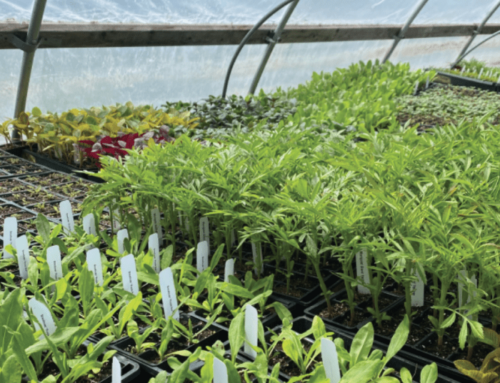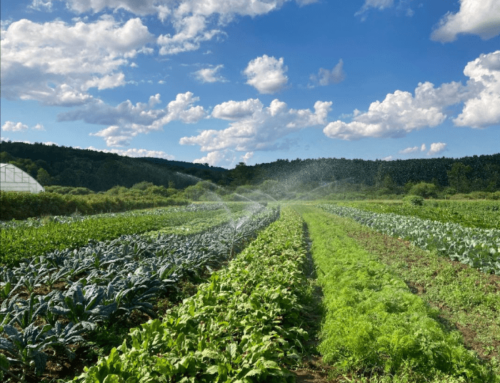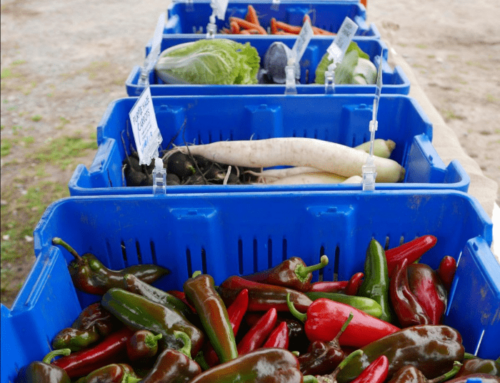By Noah Courser-Kellerman, Farmer at Alprilla Farm
Cover crops are the backbone of our soil building strategy at Alprilla Farm. Most of our land is a heavy silt loam tending towards clay, laid down by the shallow sea that covered our area after the glaciers receded. While our soils can be quite fertile, they can also be challenging to work with. When wet, they are very prone to compaction. A tractor tire or foot traffic after a rainstorm is enough to squish the air out of the soil, closing off pores and suffocating the soil life below. In this state, our soil is more like concrete than something plants can thrive in. Tillage, even when carefully timed and executed, tangibly degrades the soil’s structure after just a season or two.
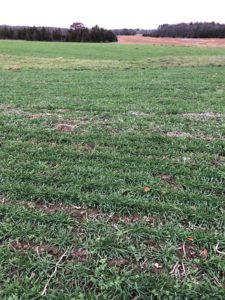
Australian Winter Peas and Winter Rye in late fall
We learned pretty quickly that no amount of subsoiling or chisel plowing, adding compost, or balancing minerals will “repair” compacted, poorly structured soil. Because there is little sand or gravel in our soil, the only way to maintain good aeration is through biological forces.
The only thing that has worked (and kept us in business) are the tenacious, opportunistic roots of cover crops. Their roots open new channels as they grow and decay, reinforcing the crumbly structure (aggregates) of the soil around them with exudates that feed friendly microbes and glue soil particles together like timbers shoring up a tunnel in a mine. Mycorrhizal fungi, fed by the plant roots in exchange for mineral nutrients, make their own long-lasting glues. Earthworms tunnel deeply, eating decaying plant material and depositing nutrient rich castings loaded with good microbes on the soil’s surface. The soil breathes again. Life in the soil creates an environment that fosters more life.
As in human societies, diversity lends depth, stability, resilience and beauty to our farms. Cover crop mixes or “cocktails” are an innovative way to achieve greater benefits for the soil than one or two species alone could provide. Too often, however, not enough attention is given to the individual species in a mix and what they need to thrive.
The group of plants, in my experience, which is always included in a cover crop mix but does not always thrive is the Legume family. With a little forethought and attention to timing, these plants can be harnessed to fix all the nitrogen your cash crop needs, while improving your soil’s tilth and breaking up compaction in ways that no other plant family can. Red clover, yellow sweet clover and Austrian winter peas are indispensable on our farm.
Austrian winter pea Pisum sativum
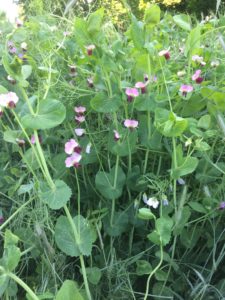
Australian Winter Pea in full bloom
Austrian winter peas are the same familiar species as garden peas and field peas, but with a key difference: When planted in the early fall, they will go dormant but survive the winter, growing up to six feet tall the following spring. Like hairy vetch, Austrian winter pea benefits from planting with winter rye. The peas climb up the rye stalks, forming a dense thicket, head high, almost impossible to walk through and studded with purple flowers.
This kind of biomass is ideal for suppressing weeds in no-till farming. We have successfully killed this winter pea/rye mix with a roller crimper and planted winter squash into the mulch. Tomatoes, peppers, corn, eggplant, melons and other main season crops would be ideal candidates for this cover crop based no-till system. On a smaller scale, tarps (either opaque for occultation or clear for solarization) can be used after the crop is flattened by hand or other mechanical means. I have heard of rolling a cover crop using a flail mower with the PTO disengaged. If tillage is used, consider incorporating before the crop gets too unmanageable, or shred with a flail mower first.
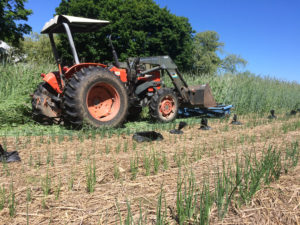
Rolling Crimping Australian Winter Pea and Winter Rye
We drill rye and Austrian winter pea in a 50/50 mix at 150 lb/acre (for smaller areas divide rate/acre by 43560 and multiply by the square footage of the area you intend to plant). If broadcasting, increase the rate a little, and try to make sure there is decent soil or mulch coverage to ensure good germination. We had some luck this year sprinkling seed between rows of kale mulched with sweet clover residue and then irrigating heavily.
More than any other cover crop we grow, planting date is important for Austrian winter pea. If planted too early, winter peas will grow fast and resemble field peas. Like field peas, they will winter kill. Planted too late, your cover crop won’t be able to protect the soil and catch nutrients as effectively, and may heave out of the ground if the soil repeatedly freezes and thaws. We find that a week on either side of the fall equinox works well.
In addition to being a superb cover crop, Austrian winter pea is delicious. Starting in late April or May, the rampant new growth of the peas is an early season “bonus crop.” We have snapped off the growing tip of the vines for sweet, pea-flavored greens to fill CSA boxes in the lean early season. Chefs love the purple flowers, too!
Red Clover Trifolium pratense
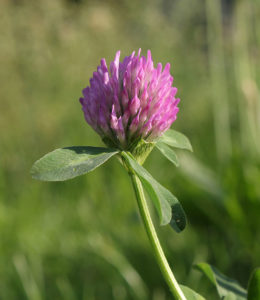
Red Clover in bloom
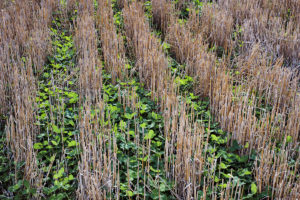
Red Clover growing up through wheat stubble
Humble red clover is easily the most powerful soil conditioner I have seen. Compacted, brick-rubble soil can be turned to crumbly, rich chocolate cake in one season. Red clover has a deep penetrating taproot and fibrous lateral roots that break up plow pans and bust clods. The benefits of this plant are numerous: As livestock feed, bee forage and plant medicine, it is invaluable. Farmers have appreciated red clover for a long time, using it as a forage and soil conditioner in the traditional American grain and forage rotation of Corn-Oats-Wheat-Sod (the latter being a mix of clover and timothy or orchard grass). We use clover in this traditional way, frost seeding it into our winter wheat crop in March. Clover seedlings are more shade tolerant than most weeds. As the wheat grows, the tiny clover seeds germinate and get established. When the wheat dries down and is harvested in mid July, the clover quickly covers the ground, forming a dense mat. We mow it to knock down any crabgrass or other weeds once in August, then let it grow through the fall and into the next growing season.
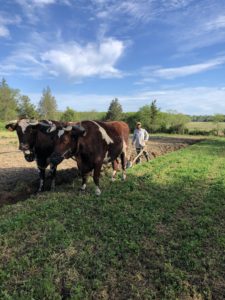
Shallowly plowing down Red Clover
Red clover is a weak perennial, meaning that it will grow for three or more seasons, but loses vigor after the second growing season. Because it is a perennial, it can be challenging to kill it without tillage. We have had some success with solarizing to kill the top growth, then mulching to smother regrowth from the roots. Usually, though, we shallowly plow it down. We typically plow down at the beginning of May for potatoes, or wait till mid June for fall brassicas. No nitrogen will be needed for crops following plowed down clover if it was a decent stand and you have reasonably good organic matter. If you have the land base for it, a pasture mix of red clover and grasses for three seasons will do even more to restore land for vegetable farming.
Establishing red clover, in my experience, requires bare soil, which presents a challenge to tillage reduction. Frost seeding has not worked for me when I’ve tried it on no-till grain fields. I think this is because the residue from mulch or previous crops between the winter grain plants makes for poor seed to soil contact and a habitat for slugs. Red clover seed is very small- an inch of straw on the ground may be too deep for clover seedlings to germinate through. However, if you do have bare soil, either from tillage or prolonged tarping, or if you rake the soil clean before establishing a winter grain “nurse crop,” establishing clover is easy. Broadcast 20 lb/acre in spring when the soil is regularly freezing and thawing. As the surface of the soil heaves and melts, the clover seed is incorporated just enough to germinate and get established. In a vegetable farming system, one could frost seed clover into winter rye, then mow the rye to use as straw just after it heads out. Be sure to inoculate the seed if you have not recently had clover growing there. Red clover can be planted later in the season, up until mid-August, but will have more competition from weeds.
Yellow Sweet Clover Melilotus officinalis
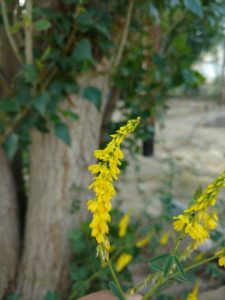
Yellow Sweet Clover in bloom
Yellow Sweet Clover is a versatile legume that can be established more easily at different times of the growing season than Austrian winter pea or red clover. It is a true biennial, like carrots or onions, in that it completes its life cycle in two seasons. The first season is spent storing food in a large, almost carrot like taproot that penetrates compacted clay and plowpans, while fibrous lateral roots break up clods and re-aggregate the soil. The following spring, the sweet clover puts its energy into top growth and flowering, topping five feet by late May on our farm. If left to grow, the plants are covered in spikelets of yellow flowers resembling tiny lupines by the first week of June, which are excellent bee fodder. As the flowers mature and set seed, the plant dries down and dies.
Sweet clover’s biennialism is the key for successful management as a cover crop. Once flowering begins, the plant has committed its energy to above ground growth. If its stems are severed or broken, it will be unable to regrow and will die. Like rye, vetch, and Austrian winter pea, sweet clover is ideal for organic, no–till farming. Mowing or rolling/crimping at the beginning of full bloom would be a great way to set up a field for main season vegetable crops. On our farm, we had great success by rotary mowing, then occulting for a few weeks before planting fall brassicas. A word of caution: I attempted to mow a stand of sweet clover with a flail mower this summer, and made it five feet before I had a giant ball of clover plants wrapped around the drum. Maybe a better flail mower, with sharp knives, with low ground speed and high rpm would do it. I think that for no-till systems, though, rolling then tarping is the way to go.
Establishing yellow sweet clover is relatively easy. Its seeds are much bigger than red clover, giving it a little more resilience to high residue conditions, drought and slugs. In bare ground (tillage) systems, sweet clover can be broadcast into main season crops like corn or squash at the last cultivation at 30 to 40 lb/acre. This will work even better if done just before a rainstorm or irrigation. Like red clover, sweet clover seedlings are shade tolerant to a degree, though they will be starved out by too dense of a canopy above them. Another way that I have established sweet clover successfully is by no till drilling it in late July into grain stubble where red clover failed to establish by frost seeding. An equivalent situation in a market garden might be following garlic or onion harvest, or the removal of other early season crops. Because sweet clover takes some time to cover the ground, I think it’s a good idea to add some other species to a cover crop mix. For an August seeding, I would add field peas, buckwheat, oats and even sunflowers to the mix, at a light rate. Broadcasting sweet clover into thin mulch between vegetable rows would work as long as there were a few days of wet weather or irrigation to let them get their roots down into the soil.
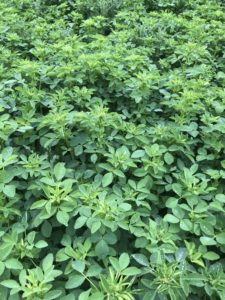
Yellow Sweet Clover in Mid May
If yellow sweet clover has an Achilles heal, it is frost heaving. Some springs, I notice sweet clover plants pushed up almost out of the ground, standing on their taproot stilts. Often, these plants recover and grow ok, but sometimes they die. I recommend broadcasting some rye into a pure stand of sweet clover in early or mid September to help mitigate this problem. The rye roots form enough of a sod to hold the lateral roots of the clover in the ground.
I think these cover crops have a place on all vegetable farms. Legumes are generous plants: when given the right conditions to get going, they give back much more than they take, harnessing the sun’s power to run the flywheel of soil fertility. They help our crops thrive, and we are grateful to them. I hope they find a home on your farms and gardens too.
Seed Sources:
NOFA bulk order (Jan 1-31 annually)

